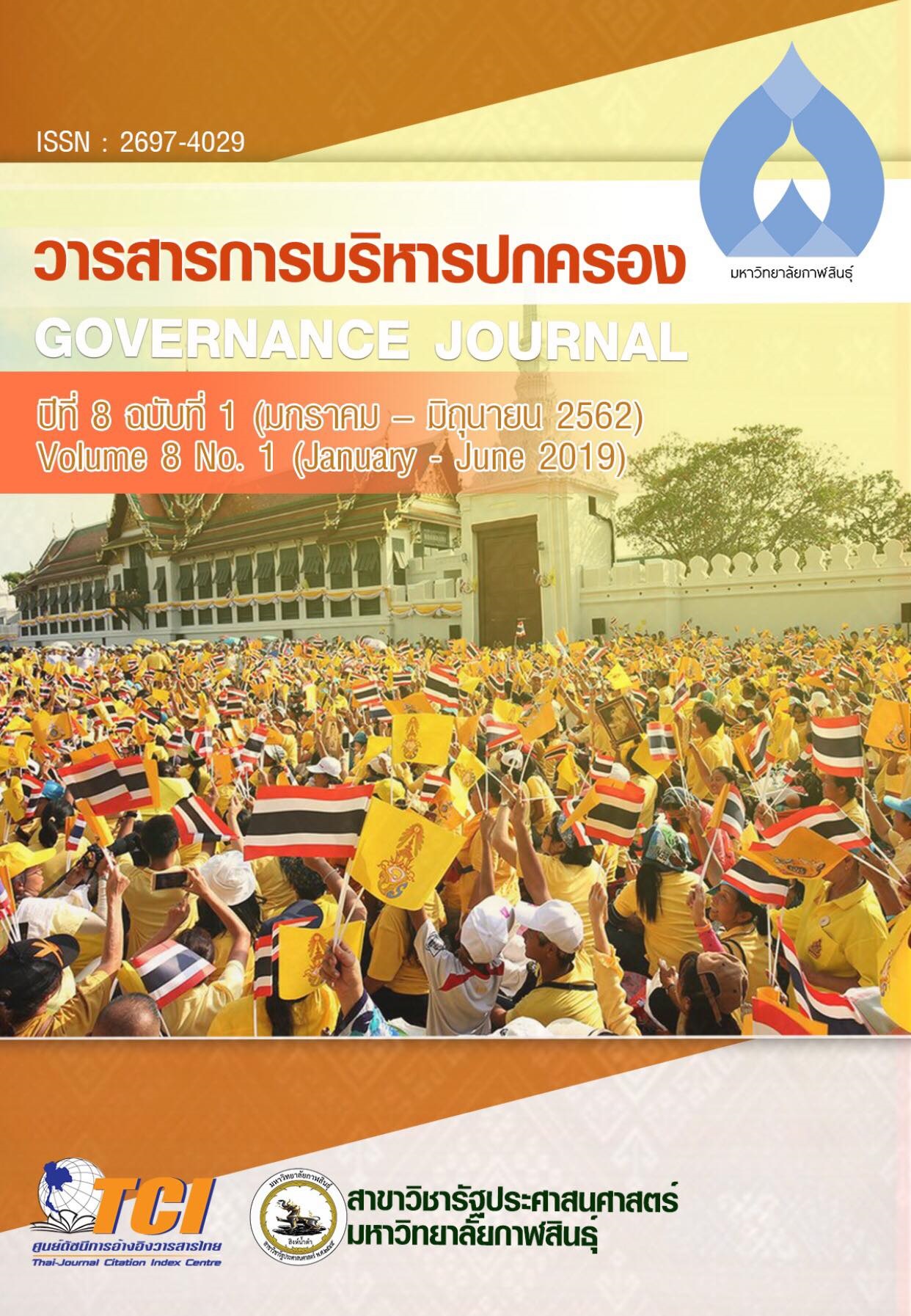Isan Adobe House : Model and Utilization
Keywords:
Isan Wisdom, Isan Adobe House, Utilization ModelAbstract
Abstract
Originally, Isan people built homes using woods and related natural material. Later natural building materials were decreased and scare. Clay was chosen as new building materials. Adobe houses were strong and long-lasting but not water-resistance. They are also suitable for Isan people’s way of life. This article aims to present the perspective of the development adobe house model based on Isan wisdom. The research objective was to develop model of Isan adobe house based on Isan wisdom. The research methodology was used in this study by collecting, analyzing, and synthesizing information from 9 men villagers and key informants in Kalasin, Chaiyaphum, and Yasothon provinces using indepth-interviews and knowledge management. The study found that Isan adobe houses were applied from traditional Thai house, “Baan Song Thai”. Each house was built on unflooded land and had a concrete foundation so that moisture was kept away from the house. The house was spherical emphasizing living space and strength. The raw-earthen bricks used were placed horizontally making the walls very thick and insulated. The house consisted of a large bedroom, a ramp, a kitchen, a porch, and a high roof. The roof allowed ventilation. The cost was only the thousand. The house was sufficient, strong, sturdy, and easy to fix.
Downloads
References
กระทรวงพัฒนาสังคมและความมั่นคงของมนุษย์. (2554). ความมั่นคงของ
มนุษย์ประเทศไทย ปี 2554. [ระบบออนไลน์]. แหล่งที่มา
www.bps.m-society.go.th/uploads/content/download/ 539681f52ccac.pdf (24 ธันวาคม 2561)
จักรสิน น้อยไร่ภูมิ. (2556). บ้านดินในรวันดา สร้างง่าย ราคาถูก
เป็นมิตรกับสิ่งแวดล้อม. [ระบบออนไลน์]. แหล่งที่มา
https://www.creativemove.com/architecture/masoro-village-project-rawanda/(22 สิงหาคม 2018).
จตุพร ตั้งศิริสกุล. (2550). การประยุกต์ใช้วัตถุดิบทางธรรมชาติในการเพิ่ม
ประสิทธิภาพของก้อนอิฐดินดิบเพื่อใช้ในการก่อสร้างบ้านดิน.
วิทยานิพนธ์มหาบัณฑิต สถาปัตยกรรมศาสตร์และการผังเมือง, มหาวิทยาลัยธรรมศาสตร์.
โจน จันได, แดเนียล ดี ซีราส และสุรัช สะราคา. (2555). บ้านดินวิธีง่าย ๆ
ของคนอยากมีบ้าน. พิมพ์ครั้งที่ 5. กรุงเทพฯ : เกษตรกรรม
ธรรมชาติ.
ฉัตรทิพย์ นาถสุภา. (2548). แนวคิดเศรษฐกิจชุมชน ข้อเสนอทางทฤษฎี
ในบริบทต่างสังคม. พิมพ์ครั้งที่ 2 กรุงเทพฯ : อัมรินทร์พริ้นติ้ง.
ณภัทร ศรีวัฒนประยูร. (2557). เรื่องน่ารู้ของบ้านดินที่สร้างด้วยอิฐดินดิบ.
สถาบันวิจัยและพัฒนา มหาวิทยาลัยเทคโนโลยีราชมงคลธัญบุรี.
ธนา อุทัยภัตรากูร. (2548). จากดินสู่บ้าน สร้างบ้านดิน. พิมพ์ครั้งที่ 4
กรุงเทพฯ : เฟื้องฟ้า พริ้นติ้ง.
นิรนาม. (2560). บ้านดินทรงกลม. เข้าถึงเมื่อ 25 ตุลาคม 2561. เข้าถึงได้
จากhttp://www.monolithic.org/floo/floorplans-pc/io-24/photos.
พลเดช วรฉัตร. (2554). บ้านดินกับความคิดพอเพียง. เข้าถึงเมื่อ 25 ตุลาคม 2561. เข้าถึงได้จาก http://www.gotoknow.org/blog/agriculturesopon/44221.
สิทธิพงษ์ เพิ่มพิทักษ์. (2555). เทคนิควิธีการสร้างบ้านดิน. วารสารวิชาการ
ศิลปะ มหาวิทยาลัยนเรศวร พิษณุโลก. 2(2), 93-102.
อนุกูล ตันสุพล. (2559). นิเวศวิทยาวัฒนธรรม : กุญแจสู่การพัฒนาที่
ยั่งยืน. วารสารวิชาการ คณะมนุษยศาสตร์และสังคมศาสตร์ มหาวิทยาลัยสงขลานครินทร์ วิทยาเขตปัตตานี. 12(1). 193-221.
เอกวิทย์ ณ ถลาง. (2544). ภูมิปัญญาอีสาน. กรุงเทพฯ : บริษัทอมรินทร์
พริ้นติ้ง แอนพับลิชชิ่ง จำกัด (มหาชน).
Mgr Online. (2551). บ้านดิน “ถู่โหลว” มรดกจีนมรดกโลก. เข้าถึงเมื่อ
9 สิงหาคม 2561. เข้าถึงได้จาก
https://mgronline.com/china/detail/951000008
Translated Thai References
Jandai, J., Daniel, D. C. and Surus, S. (2012). A Simple
house for people who want to have a house. 5th eds.
Bangkok : Natural agriculture.
Mgr Online.(2008). Adobe House “Tu Loow” Chinese heritage
World heritage. [Online] Source: https://mgronline.com
/china/detail/951000008 (9 August 2018)
Ministry of Social Development and Human Security. (2011).
human security in Thailand 2011 years. [Online].
Sources: www.bps.m-society.go.th/uploads/content/
download/539681f52ccac.pdf (24 December 2018).
Narsupha, C. (2005). Economic concept Theoretical
proposals in the community context. 2nd eds. Bangkok : Amarin Printing.
Na Thalang, E. (2001). Isan Wisdom. Bankok: Amarin printing
& publishing public company limited.
Niranam. (2017). Round-shaped clay house. [Online].Sources:
http://www.monolithic.org/…/floo…/floorplans-pc/io-
24/photos (25 October 2018)
Noiraiphum, C. (2013). Adobe House in Rawanda easy to
create, cheap environmentally friendly.[Online].Sources:
https://www.creativemove.com/architecture/masoro-village-project-rawanda/ (22 August 2018).
Pempithak, S. (2012). Techniques for building a clay
house. Academic Art journal, Phitsanulok, Naresuan University. 2(2), 93-102.
Tansupol, A. (2016). Cultural Ecology : A Key to Sustainable
Development. Journal of Humanities and Social sciences Songklanakarin University. 12(1), 193-221.
Thangsirisakul, J. (2007). The use of natural materials for
enhancing the performance of adobe brick in earth construction. Master’s thesis Fuculty of Architecture and Planning, Thammasat University.
Srisawatprayoon, N. (2014). Interesting stories of clay
houses built with raw clay bricks. Institute of Research
and Development Rajamangala university of technology thanyaburi.
Worachat, P. 2011. Adobe house with sufficient thought. [Online].Sources: http://www.gotoknow.org/
blog/agriculturesopon/44221 (25 October 2011)
Uthaiphattrakoon, T. (2005). From the soil to the house,
building the soil house. 4th eds. Bangkok : Fueng Fah
Printing.






